|

Keyhole surgery:
New hope for prostate cancer patients
By Carol Aloysius
Cancer of the prostate is on the rise. The hidden killer disease, now
a global phenomenon due to the rise in ageing populations worldwide, is
also seeing an upward trend among the Lankan grey male population, with
many patients being diagnosed at an advanced stage by which time the
disease is incurable. Health authorities stress that the lives of many
prostrate cancer patients could be saved through early detection,
followed by early treatment using new improved surgical treatments that
include keyhole (Laproscopy) and Robotics. The good news is that these
new surgical techniques which were once available in other countries are
now available in Sri Lanka as well.
A team of doctors Sohan Perera, Chathura Hingalagoda, Munipriya
Willaarchchi, Jeevani Rajasinghe (Consultant Anaesthetist) led by
Consultant Urologist & Kidney Transplant surgeon Dr Niroshan Seneviratne
supported by a specialised nursing team successfully carried out
laparoscopic surgery for Cancer of the Prostate on a 61-year-old patient
for the first time at Sri Jayewardenepura General Hospital in February
2014.
Since then laparoscopic removal of the prostate is offered for
patients with early prostate cancer at Sri Jayewardenepura General
Hospital.
|
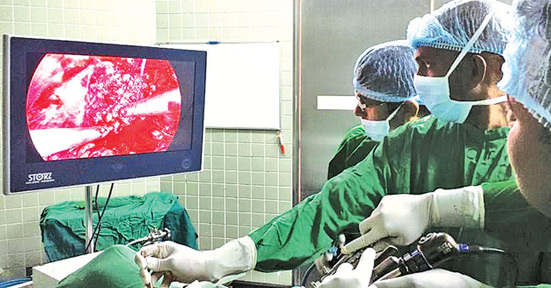
Laparoscopic surgery in progress |
DR NIROSHAN SENEVIRATNE in this interview with the Sunday Observer
discusses the adverse impacts of the hidden killer and how the path
breaking surgery he and his specialised team performed recently, can
benefit prostrate cancer patients in Sri Lanka, in the future.
Excerpts…
Q. Prostate cancer is now on the rise globally. What is this
disease?
A. Prostate is an arecanut (puvak) sized gland located at the
base of the urinary bladder, in front of the rectum. It surrounds the
beginning of the urethra, the tube that passes from the bladder to the
penis that carries urine and semen. Prostate cancer is a disease in
which some of the prostate cells become cancerous. In this disease,
abnormal cells formed in the prostate gland grow uncontrollably, which
can spread to other parts of the body. This disease is the commonest
male cancer worldwide. Generally it affects nearly one in 1,000 men in
the western world. Due to the ageing population the incidence of
prostate cancer is on the rise. Over 90 percent of prostate cancer cases
are curable if they are detected and treated in the early stages.
Q. Who are the highest risk groups? Young men? Middle aged
men? Elderly men? Why?
A. Nearly 30 percent of 50-years-olds have the disease,
increasing up to 80 percent at 80 years. However only a small proportion
of patients develop clinically significant cancer. So increasing age is
a risk factor.
Q. Is it hereditary?
A. Yes. Nine percent of patients who get prostate cancer have
a familial disease. The gene named BRCA1 responsible for this has been
found. So presence of prostate cancer among first degree relative is a
high risk factor for the other family members.
Q. What is the percentage of Sri Lanka’s population affected
by this disease?
A. The exact percentage is unknown. One study has roughly
estimated nearly 300 cases reported within a year 2005. I think this is
truly an underestimation of the figure in our country.
Q. What is the global percentage?
|

Prostate anatomy |
A. Three percent of men worldwide die of prostate cancer. It
is the most common cancer in males accounting for nearly 25 percent of
all male cancers.
Q. What are the factors that cause the disease?
A. It is multifactorial. Male hormone testosterone has a
promotional effect on prostate cancer. Increasing age, Africans,
Americans and family history are other risk factors for the disease.
Also obese people have a higher risk of acquiring the disease. Sexual
activity, vasectomy and prostate infections have no bearing for the
cancer.
Q. Does environment play a role?
A. Epidemiological studies have shown less exposure to
sunlight may have a role. This may be a reason for the disease to be
more prevalent in Scandinavian countries.
Q. What about diet?
A. There is no direct relationship between diet and prostate
cancer.
However populations with high fat diets, particularly those who
consume meat products are at higher risk of the disease. Soy products,
cooked tomatoes, pomegranate juice, Vitamin A, D, and E have shown some
beneficial effect in preventing the cancer.
Q. Can it be prevented? How?
A. Yes. Two recent studies have shown that use of drugs called
finesteride and dutasteride in long-term, reduce the chance of prostate
cancer.
|
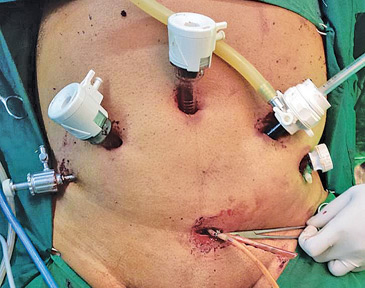
Five ports introduced through the belly for the procedure |
|
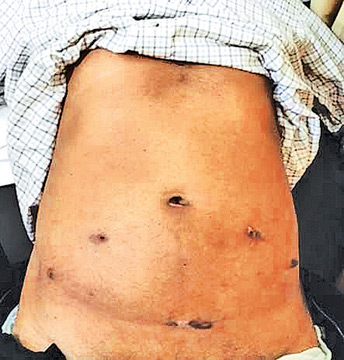
Outcome after two weeks from surgery - appearance of scars |
|
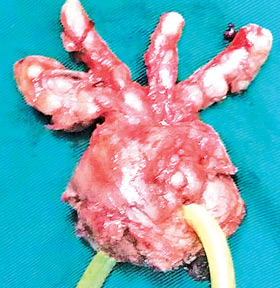
Cancerous prostate taken out after surgery |
Q. What are symptoms of prostate cancer?
A. Prostate cancer does not usually cause any symptoms in its
early stage which is called the Asymptomatic stage. Your doctor may have
spotted a sign during a routine check-up or looking at a blood test
called PSA.
If the cancer grows to compress the urethra, it will cause the
following changes in your bladder habits.
This is the Symptomatic stage.
They include: difficulty in passing urine, increase urinary
frequency, poor stream, hesitancy to pass urine, straining etc.
These symptoms commonly are caused by non-cancerous prostate
conditions called benign prostate enlargement frequently seen among
elderly men.
As the prostate cancer spreads to the bone and lymph glands the
following Advance stage symptoms are noticeable:
Pain in the back, hips, thigh. Swelling of the scrotum, penis, legs
and feet. Weight loss. Fatigue. Loss of appetite.
Q. How does early detection help?
A. Fortunately prostate cancers grow slowly. If detected early
before the prostate cancer spreads, it can be cured in 90 percent of
patients. In the rest the disease can be controlled to reduce morbidity
specially bone pain and fractures and early deaths.
Q. What are the methods used for early detection? X-rays?
Blood specimens?
A. A simple blood test named PSA (prostate specific antigen)
can be done.
Also, during a rectal examination where by placing a gloved finger
into the rectum over the prostate, a doctor can feel the shape and the
consistency of the prostate. These two tests in combination have a 50
percent to 70 percent sensitivity of detecting a prostate cancer.
Q. How is prostate cancer diagnosed?
A. TRUS biopsy is the ultimate test to diagnose a cancer. TRUS
stands for Trans Rectal Ultra Sound. This is a specialised scan where a
probe is placed in the rectum to get some pictures of the prostate. At
the same time a special needle is passed to the prostate to obtain a
sample of tissues (biopsy) for the diagnosis.
Q. What are the methods used in Sri Lanka?
A. Both PSA blood test and TRUS biopsy are available in Sri
Lanka.
Q. How do you treat prostate cancer?
A. Treatment options are quite a complex process. From the
biopsy report the cancer is graded into low risk, intermediate risk and
high risk disease. Supported by further scans such as CT scan, MRI scan
and Bone scans, the cancer is also stage in to the same.
‘Stage’ means to what extent the cancer has spread beyond the
prostate. Patients can be treated by surgery, ray treatment or by drug
therapy depending on the grade and stage.
Q. What are the methods that are traditionally used to treat
the disease in most hospitals?
A. If a prostate cancer is diagnosed at early stage, removal
of the entire prostate gland is done. This is done by open surgery by
making an incision in the lower abdomen. This method of surgery is
available in many hospitals. In case the patient presents in the late
stage, a scrotal surgery is done to reduce the testosterone (male
hormone) production which is important to control the advance disease.
New techniques
Q. I understand you are a pioneer in a new technique used for
treating prostrate cancer patients. Tell us more about it. Is it
invasive or non invasive? How is it done?
A. Laparoscopic Radical Prostatectomy is a keyhole method
where the entire prostate is removed without making a big cut in the
belly.
Here under General anaesthesia small stab incisions; in the size of
half centimetre to one centimetre are made in the belly of these
patients. These are called port site incisions. Generally five ports are
used to introduce small tubes. Through the centre tube a special camera
(laparoscope) is inserted to the belly where a magnified view of the
internal organs is seen using special TV monitor. The camera is held by
the assistant surgeon. Using different working instruments through rest
of four tubes/ports the entire cancerous gland is removed by the
operating surgeon. Finally the continuity of the urine tract is made by
stitching the bladder to the urethra.
Q. Usually, patients undergo prostate surgery by means of key
hole surgery called TURP. Is this a similar or different to this
surgical method?
A. TURP means transurethral resection of prostate. This is is
a key hole method where the prostate gland is cored from inside the
urethra by passing a special instrument along the urethra. Here the
prostate coverings (capsule) are left in the patient. This is a surgery
done for prostate enlargements due to non-cancerous causes.
Q. What are the advantages of this new method as against the
conventional methods? How does it enhance the quality of life of the
patient?
A. Due to a six times magnified view during the laparoscopic
surgery the surgery can be done very precisely with minimal damage to
blood vessels and nerves. Hence the operative blood loss is less.
Furthermore the key hole method has less post-surgical pain and the
patient recovers faster with minimal requirement of pain relief
medications. Patients can also be mobilised early with shorter hospital
stay and early return to normal activity.
Q. How long does it take for him to return to his usual
activities?
A. About two weeks.
Q. Is this new treatment available in most state hospitals? Do
you see it replacing open surgery in the near future?
A. This new method was initially introduced to Sri Lanka at
the National Hospital by a team of four Urologists led by Prof. Neville
Perera nearly eight months back.
At present laparoscopic prostate service is available at National
Hospital and at the Sri Jayawardenepura General Hospital. However with
the return of more newly trained urologists to the country, we expect
many hospitals will transform from open surgery to laparoscopic surgery
in the future.
Q. Has the world moved beyond laparoscopic surgery for
prostate?
A. Yes. Now this surgery is commonly done with the use of a
Robot; Robotic Radical Prostatectomy. It will be available in Sri Lanka
for our patients in the near future.
Q. Do you foresee an increase in prostate cancer patients in
the future? Why?
A. Considering that populations are ageing fast both in Sri
Lanka and globally, many more patients are likely to be detected with
prostate cancer in the future.
Q. Are there any other methods of treatment for this disease?
A. Apart from surgery ray treatment, use of Ultrasonic waves (HIFU)
or rapid cooling and thawing the prostate (cryotherapy) can be done to
treat early prostate cancer. However the latter two is done only in
limited settings.
Q. Are there any other surgical treatments for patients who
have reached the advanced stage?
A. When prostate cancer has spread to the bones removing the
cancerous gland is not possible. Prostate cancer growth is dependent on
male hormone name testosterone produced by the testicles.
At advance stage it is possible delay the progression of the disease
by controlling the cancer growth by cutting down the testosterone
hormone supply. This is achieved by a surgery of testicles or by drugs
inhibiting the testosterone action.
Q. Your message to the public?
A. Prostrate cancer is a curable disease if detected early. If
you are in a high risk group, get a PSA blood test done.
If you develop any urinary symptoms mentioned above seek medical
advice.
Suspended animation trials begin: sci-fi technology could save lives
Doctors are set to recreate a sci-fi technique as they begin
suspended animation by freezing trauma victims in the hope of keeping
them alive.
The technique will be used on ten patients who would otherwise be
expected to die from their wounds, which will likely come from stabbings
or shootings. The doctors on the project will be paged when a patient is
likely to fit the procedure. There is around one such case every month,
and they have a survival rate of less than seven percent.
Doctors will begin by removing patients’ blood. Their body
temperature will then be lowered to around 10 degrees Centigrade by
pumping a large volume of cold fluid through a tube placed in the aorta,
the largest artery in the body. After the process is complete patients
will be clinically dead. To resuscitate them, doctors will use a
heart-lung bypass machine to restore blood circulation.
|
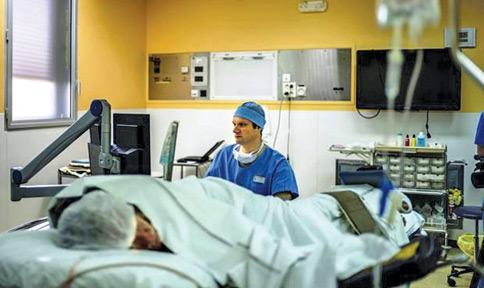
Patients will only be frozen for a few hours, but doctors
hope that will be enough to save the patients from losing
too much blood. |
“We are suspending life, but we don't like to call it suspended
animation because it sounds like science fiction,” Samuel Tisherman, the
surgeon who is leading the trial, told the New Scientist.
“So we call it emergency preservation and resuscitation.” Because the
patients will be unable to give consent to the procedure, researchers
will instead run a publicity campaign to allow potential patients to opt
out. Locals will be able to order bracelets to indicate that they don’t
consent.
The outcome of the ten initial patients will be compared with ten
other patients that could not receive the procedure. Doctors then hope
to refine the technique.Patients will only be cooled down for a few
hours, but doctors hope that will be enough to save the patients from
losing too much blood. Doctors already use cool down parts of patients’
bodies to stop blood flow and perform surgery.
The technique has been successfully used on pigs. In experiments,
scientists simulated gunshot wounds by inducing fatal wounds in the
animals and simulating medical procedure.
While all the pigs that weren’t cooled died from the wounds, 90% of
pigs that were cooled at a medium rate survived.
The surviving pigs had no long-term physical or cognitive problems.
At lower temperatures, cells need less oxygen because chemical
reactions slow down.
Similar effects to the techniques have been seen in some accidents,
where climbers and skiers have fallen into cold water and entered the
state by accident.
- The Independent
|

